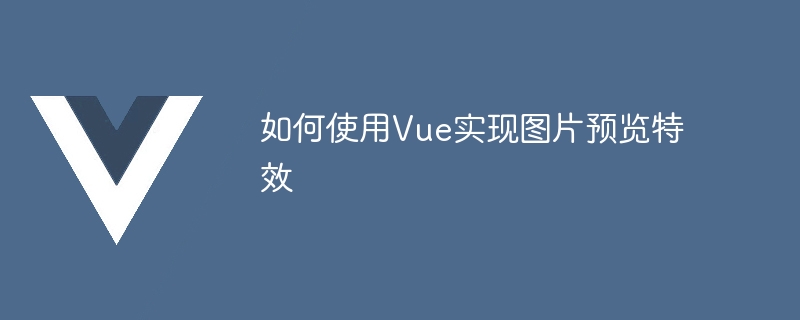Home >Web Front-end >Vue.js >How to use Vue to implement image preview effects
How to use Vue to implement image preview effects
- PHPzOriginal
- 2023-09-19 14:16:491188browse

How to use Vue to implement image preview effects
Introduction:
In modern web design, image preview effects have become a common requirement. Through image preview, the user experience can be improved and users can have a more comprehensive understanding of the image content. As a popular front-end framework, Vue provides a wealth of components and responsive data processing capabilities, which is very suitable for implementing image preview effects. This article will introduce how to use Vue to implement a simple image preview effect and provide corresponding code examples.
Step 1: Create a Vue component
First, we need to create a Vue component as a container for image preview. In this component, we will use Vue's dynamic data binding and event binding to achieve the interactive effect of image preview.
Sample code:
<template>
<div>
<img src="/static/imghwm/default1.png" data-src="currentImage" class="lazy" : @click="showPreview" alt="How to use Vue to implement image preview effects" >
<div v-if="show" class="preview-container">
<div class="preview-image">
<img src="/static/imghwm/default1.png" data-src="currentImage" class="lazy" : alt="How to use Vue to implement image preview effects" >
</div>
<span class="close-button" @click="closePreview">关闭</span>
</div>
</div>
</template>
<script>
export default {
data() {
return {
currentImage: '',
show: false
}
},
methods: {
showPreview() {
this.currentImage = '图片地址' // 图片地址通过v-for循环动态绑定
this.show = true
},
closePreview() {
this.show = false
}
}
}
</script>
<style scoped>
.preview-container {
position: fixed;
top: 0;
left: 0;
width: 100%;
height: 100%;
background-color: rgba(0, 0, 0, 0.8);
display: flex;
justify-content: center;
align-items: center;
}
.preview-image {
max-width: 80%;
max-height: 80%;
}
.close-button {
position: absolute;
top: 10px;
right: 10px;
color: #fff;
cursor: pointer;
}
</style>Step 2: Use the image preview component
Where we need to use the image preview, we can introduce the above image preview component and use v-for Instructions to generate multiple image previews in a loop.
Sample code:
<template>
<div>
<preview-image v-for="image in images" :key="image.id" :src="image.url"></preview-image>
</div>
</template>
<script>
import PreviewImage from '@/components/PreviewImage.vue'
export default {
components: {
PreviewImage
},
data() {
return {
images: [
{ id: 1, url: '图片地址1' },
{ id: 2, url: '图片地址2' },
{ id: 3, url: '图片地址3' }
]
}
}
}
</script>Summary:
Through the above steps, we can use Vue to easily implement a simple image preview effect. By clicking on the picture to trigger the preview, and then clicking the close button to close the preview, a basic interactive effect is achieved. Of course, according to actual needs, we can also make more customizations and improvements to the image preview, such as adding functions such as image scaling and rotation. I hope this article can help readers understand how to use Vue to achieve image preview effects, and encourage readers to explore more innovative interactive effects in actual projects.
The above is the detailed content of How to use Vue to implement image preview effects. For more information, please follow other related articles on the PHP Chinese website!

